ASP.NET MVC 3: Razor’s @: and <text> syntax
2011-10-01 17:50
726 查看
利用Razor中 @: 和 <text>语法 实现插入文本内容及实现多行文本显示
ASP.NET MVC 3 ships with a new view-engine option called “Razor” (in addition to the existing .aspx view engine). You can learn more about Razor, why we are introducing it, and the syntax it supports from myIntroducingRazor blog post.
Razor minimizes the number of characters and keystrokes required when writing a view template, and enables a fast, fluid coding workflow. Unlike most template syntaxes, you do not need to interrupt your coding to explicitly denote the start and end of server
blocks within your HTML. The Razor parser is smart enough to infer this from your code. This enables a compact and expressive syntax which is clean, fast and fun to type.
For example, the Razor snippet below can be used to iterate a list of products:
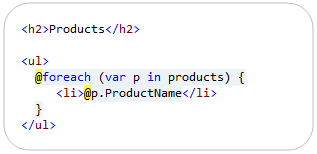
When run, it generates output like:
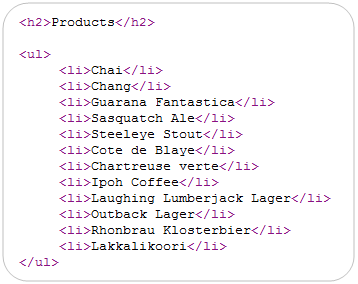
One of the techniques that Razor uses to implicitly identify when a code block ends is to look for tag/element content to denote the beginning of a content region. For example, in the code snippet above Razor automatically treated the inner <li></li> block
within our foreach loop as an HTML content block because it saw the opening <li> tag sequence and knew that it couldn’t be valid C#.
This particular technique – using tags to identify content blocks within code – is one of the key ingredients that makes Razor so clean and productive with scenarios involving HTML creation.
Using @: to explicitly indicate the start of content
Not all content container blocks start with a tag element tag, though, and there are scenarios where the Razor parser can’timplicitly detect a content block.Razor addresses this by enabling you to explicitly indicate the beginning of a line of content by using the @: character sequence within a code block. The @: sequence indicates that the line of content that follows should be treated as a content
block:

As a more practical example, the below snippet demonstrates how we could output a “(Out of Stock!)” message next to our product name if the product is out of stock:
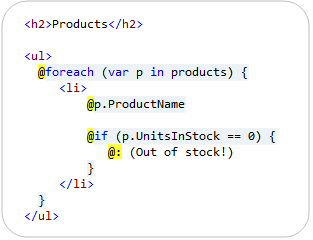
Because I am not wrapping the (Out of Stock!) message in an HTML tag element, Razor can’t implicitly determine that the content within the @if block is the start of a content block. We are using the @: character sequence to explicitly indicate that this
line within our code block should be treated as content.
Using Code Nuggets within @: content blocks
In addition to outputting static content, you can also have code nuggets embedded within a content block that is initiated using a @: character sequence.
For example, we have two @: sequences in the code snippet below:
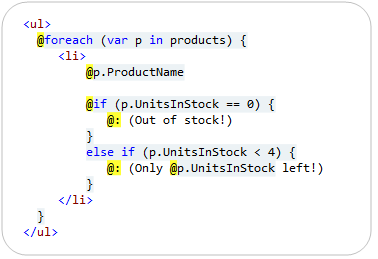
Notice how within the second @: sequence we are emitting the number of units left within the content block (e.g. - “(Only 3 left!”). We are doing this by embedding a @p.UnitsInStock code nugget within the line of content.
Multiple Lines of Content
Razor makes it easy to have multiple lines of content wrapped in an HTML element. For example, below the inner content of our @if container is wrapped in an HTML <p> element – which will cause Razor to treat it as content: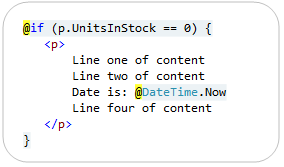
For scenarios where the multiple lines of content are not wrapped by an outer HTML element, you can use multiple @: sequences:
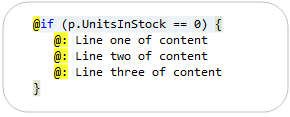
Alternatively, Razor also allows you to use a <text> element to explicitly identify content:
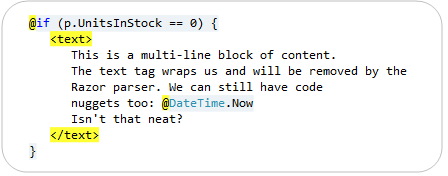
The <text> tag is an element that is treated specially by Razor. It causes Razor to interpret the inner contents of the <text> block as content, and tonot render the containing <text> tag element (meaning only the inner contents of the <text> element
will be rendered – the tag itself will not). This makes it convenient when you want to render multi-line content blocks that are not wrapped by an HTML element.
The <text> element can also optionally be used to denote single-lines of content, if you prefer it to the more concise @: sequence:
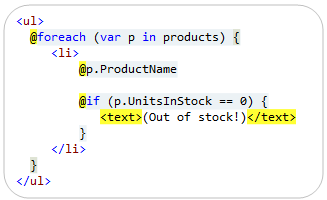
The above code will render the same output as the @: version we looked at earlier. Razor will automatically omit the <text> wrapping element from the output and just render the content within it.
Summary
Razor enables a clean and concise templating syntax that enables a very fluid coding workflow. Razor’s smart detection of <tag> elements to identify the beginning of content regions is one of the reasons that the Razor approach works so well with HTML generationscenarios, and it enables you to avoid having to explicitly mark the beginning/ending of content regions in about 95% of if/else and foreach scenarios.
Razor’s @: and <text> syntax can then be used for scenarios where you want to avoid using an HTML element within a code container block, and need to more explicitly denote a content region.
相关文章推荐
- ASP.NET MVC 3: Razor’s @: and <text> syntax
- 【转】ASP.NET MVC 3: Razor’s @: and <text> syntax
- New <%: %> Syntax for HTML Encoding Output in ASP.NET 4 (and ASP.NET MVC 2)
- ASP.NET MVC (Razor)开发 <<周报与绩效考核系统>> 总结与分享
- 如何使用<Beginning ASP.NET 3.5 in C# and VB>书中的示例代码
- Nop-Fluent+AutoFAC模式在ASP.NET MVC中的应用场景<四>
- JSON之Asp.net MVC C#对象转JSON,DataTable转JSON,List<T>转JSON,JSON转List<T>,JSON转C#对象
- ASP.NET MVC (Razor)开发<<周报与绩效考核系统>>,并免费提供园友们使用~~~
- asp.net mvc <tr>变&lt;tr/&gt; @Html.Raw 作用
- Nop-ASP.NET MVC Area概念的应用Admin后台项目<三>
- Nop-Fluent+AutoFAC模式在ASP.NET MVC中的应用场景<四>
- ASP.NET MVC 3: Razor视图引擎中 @: 和<text> 语法【转载】
- <转>ASP.NET MVC HtmlHelper用法大全
- Nop-ASP.NET MVC Area概念的应用Admin后台项目<三>
- 如何实现IEnumerable<T>和IEnumerator接口,一个ASP.NET MVC日志模型的实现
- ASP.NET MVC 3 and the @helper syntax within Razor
- Note on <Pro ASP.NET MVC 4> - 01
- ASP.NET MVC 3 Razor Syntax - RenderBody, RenderPage and RenderSection
- JSON之Asp.net MVC C#对象转JSON,DataTable转JSON,List<T>转JSON,JSON转List<T>,JSON转C#对象
- ASP.NET 中的 ViewState <转>
